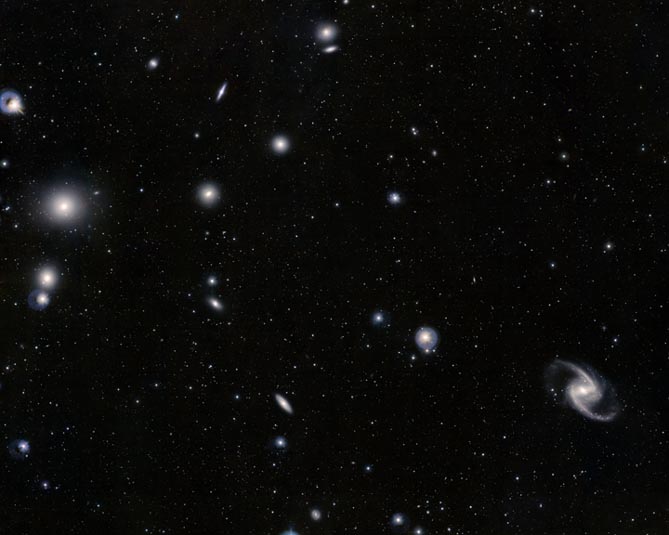
Description: galaxy group
Position: RA: 3h 35m 42.61s Dec: -35° 45' 11.94"
Constellation: Fornax
Field of view: 87.62 x 71.28 arcminutes
Number of galaxies: 58
Orientation: North is 14.9° left of vertical
Image Credit: ESO/J. Emerson/VISTA & Cambridge Astronomical Survey Unit
Release Date: December 11, 2009
2009 image: U0949 2016 image: u1612
ABOUT THIS IMAGE:
VISTA
(the Visible and Infrared Survey Telescope for Astronomy) is the latest
telescope to be added to ESO’s Paranal Observatory in the Atacama
Desert of northern Chile. It is housed on the peak adjacent to the one
hosting the ESO Very Large Telescope (VLT) and shares the same exceptional
observing conditions. VISTA’s main mirror is 4.1 meters across and
is the most highly curved mirror of this size and quality ever made. VISTA
is a survey telescope working at infrared wavelengths and is the world’s
largest telescope dedicated to mapping the sky. Its large mirror, wide
field of view and very sensitive detectors will reveal a completely new
view of the southern sky.
One of the first images to be captured from VISTA is a wide-field view
of the Fornax Galaxy Group.
The Fornax Galaxy Cluster is one of the closest of such groupings beyond our Local Group of galaxies. This VISTA image was constructed from images taken through Z, J and Ks filters in the near-infrared part of the spectrum and has captured many of the cluster members in a single image. At the lower-right is the elegant barred-spiral galaxy NGC 1365 and to the left the big elliptical NGC 1399, surrounded by a swarm of faint globular clusters. In total, there are about 58 galaxies in the group (see rollover image). The image is about 1 degree by 1.5 degrees in extent and the total exposure time was 25 minutes.
Because VISTA is a large telescope that also has a large field of view it can both detect faint sources and also cover wide areas of sky quickly. Each VISTA image captures a section of sky covering about ten times the area of the full Moon and it will be able to detect and catalogue objects over the whole southern sky with a sensitivity that is forty times greater than that achieved with earlier infrared sky surveys such as the highly successful Two Micron All-Sky Survey. This jump in observational power — comparable to the step in sensitivity from the unaided eye to Galileo’s first telescope — will reveal vast numbers of new objects and allow the creation of far more complete inventories of rare and exotic objects in the southern sky.